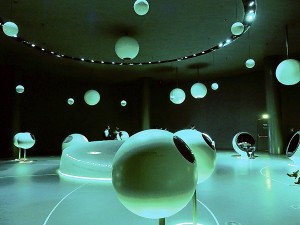Where the Internet was born and particles collide

EYEPOPPING. Inside, objects look like giant eyeballs, providing a peek of important works done by the scientific community. Photo by Tessa R. Salazar
Obsessed with mini black holes, quark-gluon plasma, atoms, particles and energy? Wondered where the World Wide Web was invented?
If these questions run in your mind as often as you fret over what shirt you’ll wear next, then chances are you’ve read about CERN—the world’s largest center for research in particle physics, which has several interlinked accelerators that provide many kinds of particles for many different experiments.
Oh, and the World Wide Web was invented at CERN (the European Organization for Nuclear Research) in Switzerland to help particle physicists around the world to communicate. Computer scientist Sir Timothy John “Tim” Berners-Lee, with the help of computer scientist Robert Cailliau and a young student at CERN, implemented the first successful communication between a Hypertext Transfer Protocol (HTTP) client and server via the Internet. Now CERN is leading work to create a “computing grid” that will harness vast amounts of computer power through networks across the world.
This writer had a chance to take a closer look at CERN (the name of which was derived from the French “Conseil Européen pour la Recherche Nucléaire”) a few weeks ago on a trip to Geneva. The CERN particle physics museum and the Globe of Science and Innovation gave a clear demonstration of the efforts of the scientists. Color-coded objects, beams of light, giant tubes, children and students co-mingle with physicists who seek to unlock the secrets of subatomic particles.
CERN is home to the Large Hadron Collider, a gigantic scientific instrument near Geneva, which spans the border between Switzerland and France, running 100 meters underground.
LHC is a particle accelerator used by physicists to study the smallest known particles—the fundamental building blocks of all things. According to the CERN public website in Switzerland, it will revolutionize our understanding of the world deep within atoms to the vastness of the universe.
LHC leapt into action on Sept. 10, 2008, amid unprecedented global press coverage and widespread fears that its energy would create tiny black holes that would supposedly destroy the Earth. According to the book “Quantum Frontier: The Large Hadron Collider,” by smashing together particles smaller than atoms, the LHC recreates the conditions hypothesized to have existed just moments after the Big Bang, the commonly agreed birth of the universe.
According to the CERN Communication Group, some of CERN’s functions are:
• Delivering a variety of beams, including high-energy muons, to study the structure of the proton, heavy ions to form new states of matter and radioactive ion beams to observe exotic nuclei.
• Producing beams of antiparticles, which are the constituents of antimatter—a kind of “mirror image” of ordinary matter. There are now several experiments at CERN making and studying antimatter.
• Studying neutrinos. The latest venture is to send a beam of these very weakly interacting particles under the Earth’s surface to the Gran Sasso Laboratory in Italy, 730 km away.
• Using particle detectors invented at CERN in techniques for medical diagnosis. Engineering for CERN, especially in cryogenics, superconductivity, vacuum, microelectronics and civil engineering, gives companies experience that they can apply elsewhere.
